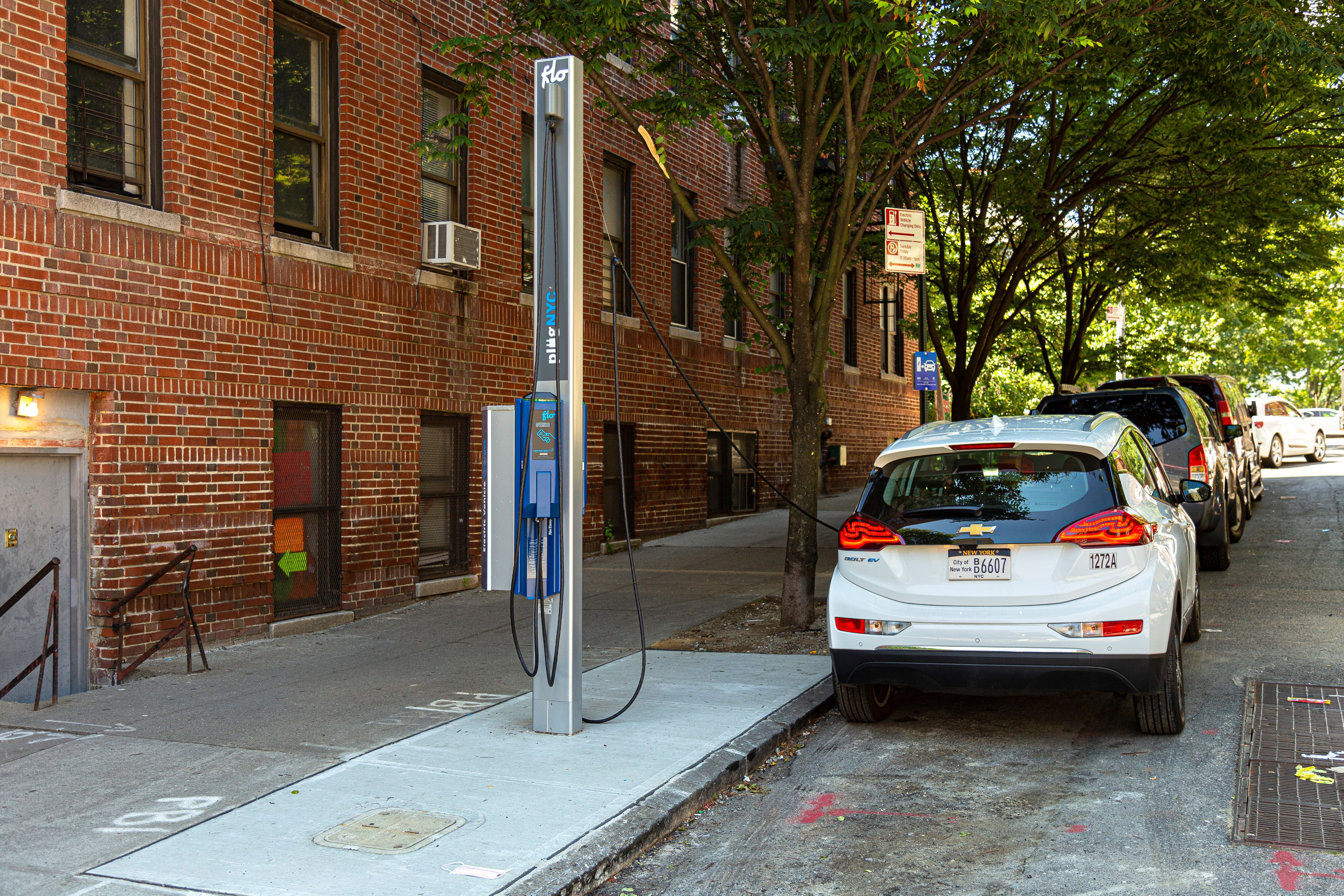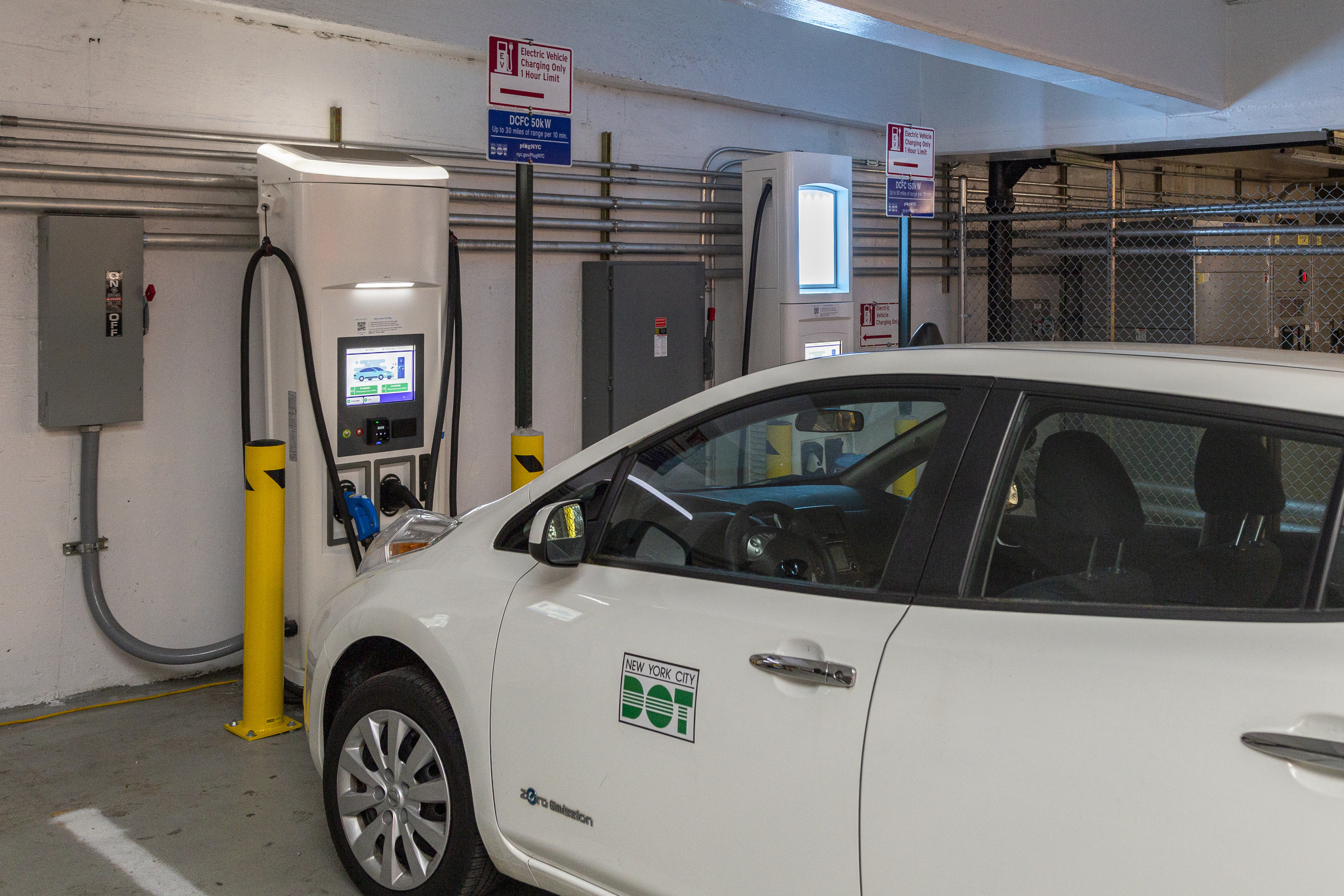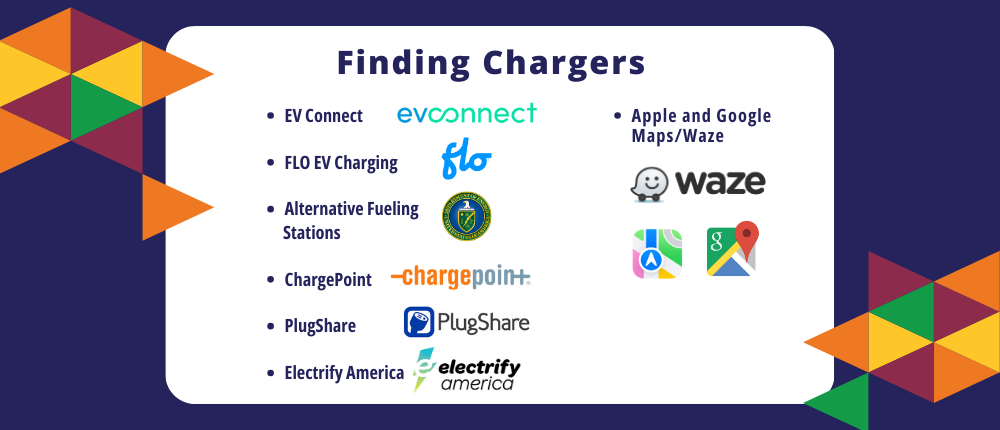
 Taxi & Limousine Commission311
Taxi & Limousine Commission311 Search all NYC.gov websites
Search all NYC.gov websites
(Click Here For More Frequently Asked Questions)
Where can I find chargers?
The City’s charging infrastructure is still developing and expected to expand significantly in the coming years. However, you can currently find chargers using a variety of resources that are publicly available and easy to use.
Map of EV Charging Stations
The U.S. Department of Energy’s (DOE) interactive map can show you where chargers are installed throughout New York State and the country.
You can type in your zip code and find individual stations with the name of the charging host, address, and contact information. Most of the stations also include charging rate information (Level 1, Level 2, DC Fast Chargers), number of charging ports, and hours of accessibility. Private and planned stations can be displayed by selecting "more search options."
You can download the corresponding iPhone app here and the Android app here.
NYC DOT Chargers
The NYC Department of Transportation (DOT) is working with partners to expand access to public EV charging across the five boroughs. In partnership with Con Edison, NYC installed 100 Level 2 charging ports for the public to use at curbside locations across the five boroughs.

(Photo courtesy NYC Department of Transportation)
A complete list of the curbside Level 2 chargers – which provide an EV with a full charge in about four to eight hours – can be found here. NYC DOT municipal parking facilities offer Level 2 charging stations.
NYC DOT is also building a network of fast-charging hubs across the city, and operates several DC fast charging hubs at city-owned public parking facilities
TLC Drivers can sign up for a 15% discount at DOT-owned fast-charging hubs through the EV Connect app. The cost of the first hour of parking will be deducted from the charging transaction. Here is a list of the current locations:
- Court Square Municipal Garage: 45-40 Court Square, Long Island City, NY 11101
- Delancey and Essex Municipal Parking Garage: 105-113 Essex Street and 112-120 Ludlow Street, New York, NY 10002
- Queens Borough Hall Municipal Parking Garage: 80-25 126th Street, Kew Gardens, NY 11415

(Photo courtesy NYC Department of Transportation)
Complete this online form with your name, TLC license number, and e-mail address you plan to use for your EV Connect account.
Other Public Charging
Knowing where to find charging will also be key to planning your trips. For instance, Revel is building a budding network for DC fast chargers across the City. They have several Superhubs across the city. Find the Revel map here.
There are also maps and apps like PlugShare, Flo EV Charging App, and EV Connect that can help you find chargers while you’re on the road, in public spaces and with some homeowners that are willing to share their plugs. Additionally, Apple and Google Maps and Waze can offer real-time locations and data about chargers.

What are the differences between the different types of EV chargers?
Understanding what type of charge you’ll get from a specific charger and what type of plug (or adapter) is a vital part of planning your trips and work schedule. Most EVs come with the necessary charging connectors and adapters to work at a variety of charging stations, but you should ask the dealer or manufacturer where and how your vehicle can best be charged.
There are three different charging levels for EVs:
Level 1 Charger:
- Standard household outlet, low voltage (120v).
- Up to 5 miles of range per hour of charging.
- Requires a special connector for the vehicle hook-up.
- Can take up to two days to fully charge.
Level 2 Charger:
- Mid-level voltage (240v), commonly used for large appliances like dryers.
- Up to 25 miles of range per hour of charging.
- Level 2 charging stations allow EV owners to charge their vehicles while parked at home, at work, or on the street.
Level 3/DC Fast Charger (DCFC):
- The fastest common charging option (over 480v).
- Can be found at a commercial property, such as a municipal parking lot or supercharging hub.
- Can provide an 80% charge in under 30 minutes, offering a quicker charging experience similar to a gas station.
Will I have a charger near me? What if there are no chargers in my area?
They are coming. The TLC’s “Charged Up!” report from 2022 identified areas in need, specifically areas where drivers live. To do this, a comprehensive approach is being taken to ensure that every New Yorker lives within 2.5 miles of an EV fast charger.
In September 2024, TLC’s “Electrification in Motion: An Update on New York City’s Electric For-Hire Vehicle Fleet” provided a progress report on charging development across the city and updates about our fleet’s transition and progress.
NYC DOT, with input from Con Edison, selected curbside locations based on projected demand for charging, geographic diversity, and input from local elected officials and community stakeholders. NYC DOT also collected input from the public on where chargers should be installed.
To enable the charging infrastructure required to accelerate the transition to an electric future, the City developed “Electrifying New York: An Electric Vehicle Vision Plan” that lays out initiatives to dramatically expand access to public chargers across the five boroughs.
This plan leverages government resources to spur private investment, with the goal of creating a network of 40,000 public Level 2 chargers citywide and 6,000 DC Fast Chargers by 2030.
Curbside Level 2 charging is one piece of NYC's broader EV strategy, outlined in PlaNYC: Getting Sustainability Done.
Additionally, as part of the City of Yes for Carbon Neutrality initiative, which has passed the Planning Commission and is up for City Council consideration, the Department of City Planning is moving to legalize EV chargers in all Commercial or ‘C’ districts – more than doubling the land area available for charging facilities – expand existing car share rules to allow EV “charger sharing,” and allow a greater share of commercial lots to be used for EV charging.
Can I charge at home?
Yes. As noted above, there are several types of chargers, but Level 1 and 2 are the most common in homes. Level 1 charging only requires a 120-volt outlet. Level 2 chargers require a 240-volt outlet and some modifications to your existing electrical infrastructure.
There are also incentives for such work. For entities such as fleet operators seeking to install EV charging stations at their businesses or owner-drivers seeking to install chargers at their homes, the most comprehensive and relevant incentive is the PowerReady program. Another program to consider at multi-unit dwellings, workplaces, or public facilities is Charge Ready NY 2.0.
According to HomeAdvisor, it can cost between $400 to $1,700 to install a Level 2 at home, with the cost varying based on the charger type and brand.
What are the different connectors and plugs and where do they work?
Most EVs use the same type of connector. For Level 1 or Level 2 charging, the standard round port is called a J1772 connector. For all non-Tesla Level 3 DC fast charging, all U.S. EVs use either CCS (which stands for “combined charging system”) or CHAdeMO plugs.
NYC DOT’s curbside Level 2 chargers are equipped with a standard J1772 connector that is compatible with most EVs.
Certain newer Tesla Supercharging stations are being equipped with an adapter called a Magic Dock, which sits in a compartment that is unlocked with the Tesla app. This will allow you to charge a non-Tesla vehicle at one of these locations.
For more information about EV charging ports, you can go to the U.S. Department of Energy website.I have a Tesla. Can I charge at non-Tesla ports?
Yes. When charging at a non-Tesla charging station, you will need to connect a J1772 adapter to the connector before inserting for Level 1 and 2 charging. Tesla provides this adapter with purchase.
Additionally, you can buy a CCS Combo 1 adapter that will allow you fast-charge at non-Tesla ports. This will increase the number of locations where you are able to charge quickly.
What should I know about battery life and charging?
When charging your EV, it’s recommended that you keep your battery between 20% and 80%, without going above or below those thresholds if it can be avoided. Once outside of that range, even fast charging times slow down, which could lead to longer lines and wait times at charging stations. It’s also better for your long-term battery life. Extreme temperatures also affect battery charging times.
What can I do to speed up charging during cold weather?
When temperatures fall, charging times tend to rise as cold batteries are slower to accept a charge. To speed up charging, it is recommended that you warm up or “precondition” your battery at least 30 minutes prior to charging. Check your vehicle’s manual for details on how to precondition your battery.
Does hot weather affect charging or battery life?
When temperatures rise to extremely high levels, EV charging times can take longer. It is recommended that you charge to 80% and do not fall below 20%. You can also “precondition” your car’s cabin, which allows you to cool the car’s interior using energy from the grid (and not your battery) before you get back on road. Do this while the car is still plugged in. Also try to park in a garage or shaded area, if possible.
Why are there no EV WAVs?
TLC is committed to accessibility and we continuously have conversations with vehicle manufacturers on the need for a commercially available EV WAV, but there are currently no EV WAVs on the market. We are confident that as technology moves forward they will become available, but regardless of whether WAVs are electric or gas, TLC will continue to require Uber and Lyft to fulfill 80% of WAV requests in 10 minutes or less and 90% in 15 minutes or less. In other words, Green Rides will not negatively impact accessibility because Uber and Lyft will still be required to dispatch WAVs accordingly.
Do I get paid more to drive an EV?
Currently, Uber drivers of fully electric vehicles are eligible for certain incentives. Lyft offers numerous charging incentives that can be found here.
What are the incentives for EVs?
There are various city, state and national incentives for EV ownership, and more specifically for TLC drivers, to help offset some costs associated with purchasing and operating an EV. For TLC-licensed drivers living in New York City, these include vehicle acquisition, reduced tolling, and charging incentives. Here is a breakdown of some of the various incentives and tax credits that can help you save on your EV:
Federal:
NOTE: Federal tax credits are set to expire on September 30, 2025.
-Federal Clean Vehicle Credit: This can save up to $7,500, depending on the vehicle. Learn more about how the credits can be applied at the time of purchase here.
Used cars: Pre-owned EVs are now also eligible for various credits. You can find more information on that here. Other federal incentives and tax credits can be found here.
NY State:
-Drive Clean Rebate: This can save up to $2,000 from the list of over 60 electric car models to choose from. Learn more about this program here. Find a list of the vehicles that qualify here.
-Con Edison’s SmartCharge NY: SmartCharge New York helps EV drivers earn cash incentives for charging their EV during off-peak times and track their energy consumption. Learn more about how to sign up here.
-More NY State-based incentives can be found here.
NYC discounts
Discounted Charging with DOT: As noted above, TLC offers a discounted charging program with NYC DOT. Drivers can sign up for a 15% discount at DOT-owned charging stations through the EV Connect app. Complete this online form with your name, TLC license number, and e-mail address you plan to use for your EV Connect account.
What if I have more questions?
For answers to more questions, please visit our Green Rides main page.



